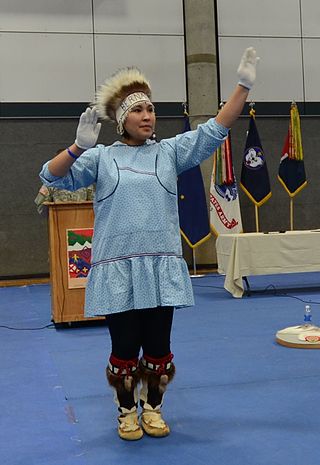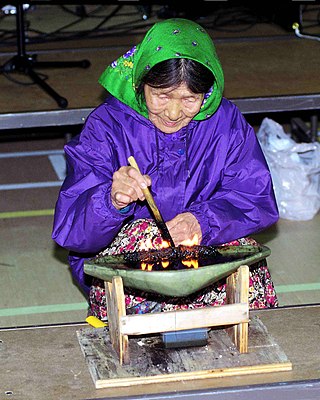Related Research Articles

Eskimo is an exonym that refers to two closely related Indigenous peoples: Inuit and the Yupik of eastern Siberia and Alaska. A related third group, the Aleut, who inhabit the Aleutian Islands, are generally excluded from the definition of Eskimo. The three groups share a relatively recent common ancestor, and speak related languages belonging to the family of Eskaleut languages.

Baffin Island, in the Canadian territory of Nunavut, is the largest island in Canada, the second largest island in the Americas, and the fifth-largest island in the world. Its area is 507,451 km2 (195,928 sq mi) with a population density of 0.03/km2; the population was 13,039 according to the 2021 Canadian census; and it is located at 68°N70°W. It also contains the city of Iqaluit, which is the capital of Nunavut.

Northern Canada, colloquially the North or the Territories, is the vast northernmost region of Canada, variously defined by geography and politics. Politically, the term refers to the three territories of Canada: Yukon, Northwest Territories and Nunavut. This area covers about 48 per cent of Canada's total land area, but has less than 0.5 per cent of Canada's population.

Igloolik is an Inuit hamlet in Foxe Basin, Qikiqtaaluk Region in Nunavut, northern Canada. Because its location on Igloolik Island is close to Melville Peninsula, it is often mistakenly thought to be on the peninsula. The name "Igloolik" means "there is a house here". It derives from iglu meaning house or building, and refers to the sod houses that were originally in the area, not to snow igloos. In Inuktitut the residents are called Iglulingmiut.

Pond Inlet is a small, predominantly Inuit community in the Qikiqtaaluk Region of Nunavut, Canada, located on northern Baffin Island. To the Inuit the name of the place "is and always has been Mittimatalik." The Scottish explorer Sir John Ross had named an arm of the sea that separates Bylot Island from Baffin Island as Pond's Bay, and the hamlet now shares that name. On 29 August 1921, the Hudson's Bay Company opened its trading post near the Inuit camp and named it Pond Inlet, marking the expansion of its trading empire into the High Arctic.

Alaska Natives are the Indigenous peoples of Alaska and include Alaskan Creoles, Iñupiat, Yupik, Aleut, Eyak, Tlingit, Haida, Tsimshian, and a number of Northern Athabaskan cultures. They are often defined by their language groups. Many Alaska Natives are enrolled in federally recognized Alaska Native tribal entities, who in turn belong to 13 Alaska Native Regional Corporations, who administer land and financial claims.

Clyde River is an Inuit hamlet located on the shore of Baffin Island's Patricia Bay, off Kangiqtugaapik, an arm of Davis Strait in the Qikiqtaaluk Region, of Nunavut, Canada. It lies in the Baffin Mountains which in turn form part of the Arctic Cordillera mountain range. The community is served by air and by annual supply sealift.

Torngat Mountains National Park is a Canadian national park located on the Labrador Peninsula in the province of Newfoundland and Labrador. The park encompasses 9,700 km2 of mountainous terrain between Northern Quebec and the Labrador Sea. It is the largest national park in Atlantic Canada and the southernmost national park in the Arctic Cordillera. It partially contains the Torngat Mountains, the highest mountains in mainland Canada east of the Rocky Mountains.

Nunavut is the largest and northernmost territory of Canada. It was separated officially from the Northwest Territories on April 1, 1999, via the Nunavut Act and the Nunavut Land Claims Agreement Act, which provided this territory to the Inuit for self-government. The boundaries had been drawn in 1993. The creation of Nunavut resulted in the first major change to Canada's political map in half a century since the province of Newfoundland was admitted in 1949.

Inuit are a group of culturally and historically similar Indigenous peoples traditionally inhabiting the Arctic and subarctic regions of North America, including Greenland, Labrador, Quebec, Nunavut, the Northwest Territories, Yukon (traditionally), Alaska, and Chukotsky District of Chukotka Autonomous Okrug, Russia. Inuit languages are part of the Eskimo–Aleut languages, also known as Inuit-Yupik-Unangan, and also as Eskaleut. Inuit Sign Language is a critically endangered language isolate used in Nunavut.

Historically, Inuit cuisine, which is taken here to include Greenlandic, Yupʼik and Aleut cuisine, consisted of a diet of animal source foods that were fished, hunted, and gathered locally.

The Inuit are an indigenous people of the Arctic and subarctic regions of North America. The ancestors of the present-day Inuit are culturally related to Iñupiat, and Yupik, and the Aleut who live in the Aleutian Islands of Siberia and Alaska. The term culture of the Inuit, therefore, refers primarily to these areas; however, parallels to other Eskimo groups can also be drawn.

Nirjutiqavvik National Wildlife Area is a National Wildlife Area on Coburg Island within the Qikiqtaaluk Region, Nunavut, Canada. It is located in Baffin Bay's Lady Ann Strait between Ellesmere Island, to the north, and Devon Island to the south. The NWA includes Coburg Island and its surrounding marine area.
The Canadian Northern Economic Development Agency is a policy initiative announced by Prime Minister Stephen Harper of the Federal Conservative Party in August 2009. The purpose of the agency is to promote economic development and prosperity while protecting national sovereignty in Northern Canada. CanNor is situated in Iqaluit, Nunavut. By centralizing this economic program in the Northern region of Canada, the Federal Government believes that it will contribute to increased participation by local communities and government in federal policy. From this, CanNor is also responsible for the Northern Projects Management Office (NPMO), which serves as a review board for economic developments in Northern Canada. As of July 2, 2014, the current President of CanNor is Paula Isaak. The Government of Canada is responsible for CanNor, with Dan Vandal, Minister responsible for the Canadian Northern Economic Development Agency, overseeing the developments within the agency. In various programs, CanNor promotes the growth of the economy, education, infrastructure development, and culture in Yukon, Northwest Territories, and Nunavut. CanNor was created from the policy initiative "Northern Strategy," developed to exercise sovereignty, promote social and economic development, protecting the heritage surrounding Native peoples in the Arctic region, as well as asserting continual governance.

The Inuit are indigenous people who live in the Arctic and subarctic regions of North America. The ancestors of the present-day Inuit are culturally related to Iñupiat and Yupik, and the Aleut, who live in the Aleutian Islands of Siberia and Alaska. The word "Eskimo" has been used to encompass the Inuit and Yupik, and other indigenous Alaskan and Siberian peoples, but this usage is in decline.

Inuit Nunangat refers to the land, water, and ice of the homeland of Inuit in Canada. This Arctic homeland consists of four northern Canadian regions called the Inuvialuit Settlement Region, the territory Nunavut (ᓄᓇᕗᑦ), Nunavik (ᓄᓇᕕᒃ) in northern Quebec, and Nunatsiavut of Newfoundland and Labrador.

According to the latest available data, Statistics Canada estimates 4,157 suicides took place in Canada in 2017, making it the 9th leading cause of death, between Alzheimer's disease (8th) and cirrhosis and other liver diseases (10th). In 2009, there were an estimated 3,890 suicide deaths.
Pat Angnakak is a Canadian politician, who was elected to the Legislative Assembly of Nunavut in the 2013 election and reelected in 2017. She represented the electoral district of Iqaluit-Niaqunnguu until 2021; she resigned her seat in the legislature in August 2021 in order to run as a Liberal Party of Canada candidate in the 2021 Canadian federal election, but was defeated by Lori Idlout of the New Democratic Party.
For many Indigenous communities in Canada, food insecurity is a major, ongoing problem. A variety of factors, from poverty, the COVID-19 pandemic, government inaction and climate change, exacerbated by both historical and ongoing discrimination faced by Indigenous Canadians, have played a role in the creation of this crisis.
Climate change disproportionately impacts indigenous peoples around the world when compared to non-indigenous peoples. These impacts are particularly felt in relation to health, environments, and communities. Some Indigenous scholars of climate change argue that these disproportionately felt impacts are linked to ongoing forms of colonialism. Indigenous peoples found throughout the world have strategies and traditional knowledge to adapt to climate change, through their understanding and preservation of their environment. These knowledge systems can be beneficial for their own community's adaptation to climate change as expressions of self-determination as well as to non-Indigenous communities.
References
- 1 2 3 4 Hotez, Peter J. (26 January 2010). "Neglected Infections of Poverty among the Indigenous people of the Arctic". PLOS Neglected Tropical Diseases. 4 (1): e606. doi: 10.1371/journal.pntd.0000606 . PMC 2811175 . PMID 20126272.
- 1 2 Kral, Michael J.; Lori Idlout; J. Bruce Minore; Ronald J. Dyck; Laurence J. Kirmayer (9 March 2011). "Unikkaartuit: Meaning of Well-Being, Unhappiness, Health and Community Change Among Inuit in Nunavut, Canada". Am J Community Psychol. 48 (3–4): 426–438. doi:10.1007/s10464-011-9431-4. PMID 21387118. S2CID 36115900.
- 1 2 3 4 5 Ford, James D. (28 May 2009). "Dangerous Climate Change and the Importance of Adaptation for the Arctic's Inuit Population". Environmental Research Letters. 4 (2): 024006. Bibcode:2009ERL.....4b4006F. doi: 10.1088/1748-9326/4/2/024006 .
- ↑ Woodham, Scott (2011-10-26). "Despite expense, Alaska's poverty rate among lowest in US". Alaska Dispatch. Retrieved 1 November 2012.
- ↑ Arctic Council, (2004) The Arctic Climate Impact Assessment. Archived 2017-09-24 at the Wayback Machine
- 1 2 Ford, James D.; Barry Smith (December 2004). "A Framework for Assessing the Vulnerability of Communities in the Canadian Arctic to Risks Associated with Climate Change". Arctic. 57 (4): 389–400. doi:10.14430/arctic516. hdl: 10535/3095 . JSTOR 40512642.
- ↑ Loring, Philip A., and S. Craig Gerlach (2009) "Food, Culture, and Human Health in Alaska: An Integrative Health Approach to Food Security." Environmental Science and Policy, Vol 12(4), pp.466–78
- 1 2 3 4 5 6 Beaumier, Maude C.; James D. Ford (May–June 2010). "Food Insecurity among Inuit Women Exacerbated by Socio-economic stresses and Climate Change". Canadian Journal of Public Health. 101 (3): 196–201. doi:10.1007/BF03404373. PMC 6973768 . PMID 20737808.
- ↑ Loring, Philip A., S. Craig Gerlach, David E. Atkinson, and Maribeth S. Murray. (2011) "Ways to Help and Ways to Hinder: Governance for Successful Livelihoods in a Changing Climate." Arctic, Vol. 64(1), 73–88.